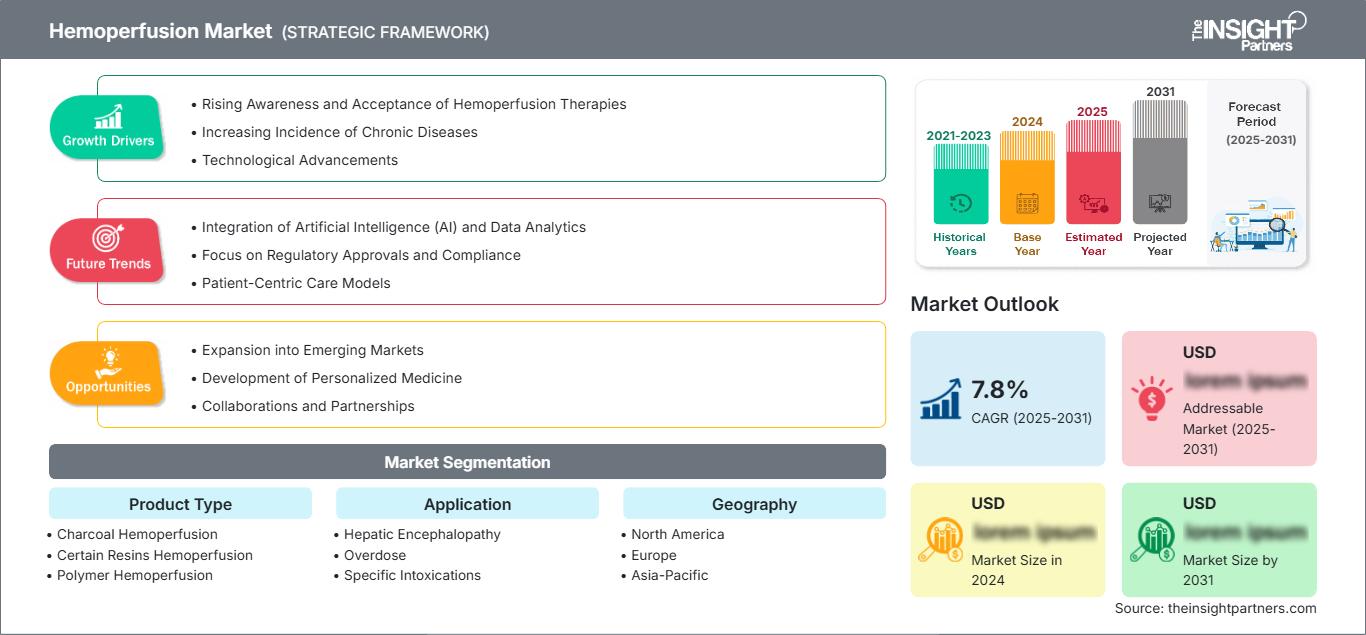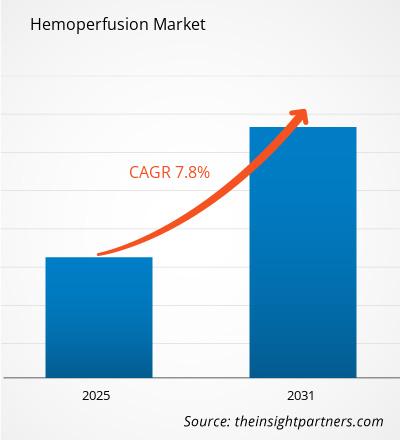The Hemoperfusion Market is expected to register a CAGR of 7.8% from 2025 to 2031, with a market size expanding from US$ XX million in 2024 to US$ XX Million by 2031.
The report is segmented by Product Type (Charcoal Hemoperfusion, Certain Resins Hemoperfusion, Polymer Hemoperfusion). The report is segmented by Application (Hepatic Encephalopathy, Overdose, Specific Intoxications, Certain Autoimmune Diseases, Other). The global analysis is further broken-down at regional level and major countries. The Report Offers the Value in USD for the above analysis and segments.
Purpose of the Report
The report Hemoperfusion Market by The Insight Partners aims to describe the present landscape and future growth, top driving factors, challenges, and opportunities. This will provide insights to various business stakeholders, such as:
- Technology Providers/Manufacturers: To understand the evolving market dynamics and know the potential growth opportunities, enabling them to make informed strategic decisions.
- Investors: To conduct a comprehensive trend analysis regarding the market growth rate, market financial projections, and opportunities that exist across the value chain.
- Regulatory bodies: To regulate policies and police activities in the market with the aim of minimizing abuse, preserving investor trust and confidence, and upholding the integrity and stability of the market.
Hemoperfusion Market Segmentation
Product Type
- Charcoal Hemoperfusion
- Certain Resins Hemoperfusion
- Polymer Hemoperfusion
Application
- Hepatic Encephalopathy
- Overdose
- Specific Intoxications
- Certain Autoimmune Diseases
- Other
You will get customization on any report - free of charge - including parts of this report, or country-level analysis, Excel Data pack, as well as avail great offers and discounts for start-ups & universities
Hemoperfusion Market: Strategic Insights

-
Get Top Key Market Trends of this report.This FREE sample will include data analysis, ranging from market trends to estimates and forecasts.
Hemoperfusion Market Growth Drivers
- Rising Awareness and Acceptance of Hemoperfusion Therapies: More health-care providers prescribe these treatments as research continues to document the efficacy of hemoperfusion for managing critical conditions. Educational programs and professional training initiatives also promote the knowledge and acceptance of hemoperfusion by clinicians, and its rates of usage are found to be on the increase in hospitals and clinics. Increased awareness among patients and health-care professionals about the merits of hemoperfusion therapies fuels market growth.
- Increasing Incidence of Chronic Diseases: The incidence of patients suffering from chronic diseases, like diabetes and hypertension, and cases related to liver disorders, has become much increased. These conditions are generally associated with complications that require treatment with a sophisticated therapeutic approach. For instance, acute failure of the liver and kidney disorders require appropriate detoxification techniques where hemoperfusion becomes essential. Health care and medical service systems are witnessing ever-increasing chronic diseases for which there is going to be an enormous demand for hemoperfusion technology, devices, and services.
- Technological Advancements: The pace of technological advancement in the market for hemoperfusion is immense, as this increases efficacy and safety in treatments. Developments in synthesizing biocompatible adsorbents and portable hemoperfusion systems increase the accessibility of the treatment but also increase its effectiveness. Therefore, such developments in synthetic adsorbents have increased efficiency already in the removal of toxins with reduced side effects. Integration of these latest digital health technologies with remote monitoring and AI-assisted treatment protocols also further supports the use of hemoperfusion in clinical settings, in turn fueling the growth of the market.
Hemoperfusion Market Future Trends
- Integration of Artificial Intelligence (AI) and Data Analytics: The infusion of AI and data analytics in hemoperfusion is changing the very face of patient care. It results in huge volumes of patient data, which would enable better decision-making and outcomes of treatment. This becomes possible because AI can predict patient responses to hemoperfusion therapies by continuously optimizing treatment protocols. Healthcare will increasingly embrace digital transformation, ensuring that, as an innovation standard, AI in hemoperfusion may serve to advance the overall efficiency of care.
- Focus on Regulatory Approvals and Compliance: As the hemoperfusion market grows, regulatory bodies are putting in greater emphasis on safety and efficacy requirements. The manufacturers are becoming increasingly more concerned with the regulatory requirements because their products are finding an entry into the market. It thus is forcing companies to invest in robust quality assurance processes as well as clinical trials to prove their respective hemoperfusion devices are safe and effective. Consequently, products with capabilities that can meet or exceed regulatory expectations are expected to find an upper hand in competition within this marketplace.
- Patient-Centric Care Models: Because healthcare providers have increasingly come to place value on patient experiences and outcomes, the transition toward patient-centered care impacts the hemoperfusion market. As such, there is pressure on companies to develop more user-friendly devices and treatment protocols that provide less discomfort and overall pain and further place emphasis on patient education and engagement, thus encouraging collaborative treatment where the patient is empowered to take an active role in his own care. Manufacturers, which focus on patient-centric innovations, are well-placed to emerge victorious in this changing landscape.
Hemoperfusion Market Opportunities
- Expansion into Emerging Markets: Emerging economies in the Asia-Pacific and Latin America regions are other key growth opportunities for the hemoperfusion market. Healthy growth in health care infrastructure coupled with greater access towards more advanced medical technology is expected to drive demand for appropriate treatment options. Additionally, the increasing middle: class population within these regions is fueling higher health care expenditure, thus creating hemoperfusion products and services opportunities. Companies that go strategically to such markets can exploit local alliances and tailor the product according to regional needs.
- Development of Personalized Medicine: The trend towards personalized medicine forms a unique opportunity in the hemoperfusion market. Therapies and treatment approaches could be significantly optimized if they are tailored according to individual patient profiles. Clinicians have started using advances in genomics and especially biomarker identification to guide their choice of appropriate adsorbent materials and treatment protocols for given conditions. Efforts to improve patient outcomes would also lead manufacturers toward competitive edges.
- Collaborations and Partnerships: It will push the area of hemoperfusion to greater innovation and entry into the market with strategic alliances between the developers of medical devices, research institutions, and healthcare providers. Shared resources and expertise will stand for new products in high: tech, clinical trial setup, and improvement of the complete treatment regimen for hemoperfusion. Being linked with universities and research centers will reveal new lines of indications that go beyond conventional indications.
Hemoperfusion Market Regional Insights
The regional trends and factors influencing the Hemoperfusion Market throughout the forecast period have been thoroughly explained by the analysts at The Insight Partners. This section also discusses Hemoperfusion Market segments and geography across North America, Europe, Asia Pacific, Middle East and Africa, and South and Central America.
Hemoperfusion Market Report Scope
| Report Attribute | Details |
|---|---|
| Market size in 2024 | US$ XX million |
| Market Size by 2031 | US$ XX Million |
| Global CAGR (2025 - 2031) | 7.8% |
| Historical Data | 2021-2023 |
| Forecast period | 2025-2031 |
| Segments Covered |
By Product Type
|
| Regions and Countries Covered |
North America
|
| Market leaders and key company profiles |
|
Hemoperfusion Market Players Density: Understanding Its Impact on Business Dynamics
The Hemoperfusion Market is growing rapidly, driven by increasing end-user demand due to factors such as evolving consumer preferences, technological advancements, and greater awareness of the product's benefits. As demand rises, businesses are expanding their offerings, innovating to meet consumer needs, and capitalizing on emerging trends, which further fuels market growth.

- Get the Hemoperfusion Market top key players overview
Key Selling Points
- Comprehensive Coverage: The report comprehensively covers the analysis of products, services, types, and end users of the Hemoperfusion Market, providing a holistic landscape.
- Expert Analysis: The report is compiled based on the in-depth understanding of industry experts and analysts.
- Up-to-date Information: The report assures business relevance due to its coverage of recent information and data trends.
- Customization Options: This report can be customized to cater to specific client requirements and suit the business strategies aptly.
The research report on the Hemoperfusion Market can, therefore, help spearhead the trail of decoding and understanding the industry scenario and growth prospects. Although there can be a few valid concerns, the overall benefits of this report tend to outweigh the disadvantages.
Frequently Asked Questions
What is the expected CAGR of the Hemoperfusion Market?
What are the driving factors impacting the Hemoperfusion market?
1. Rising Awareness and Acceptance of Hemoperfusion Therapies
2. Increasing Incidence of Chronic Diseases
What are the factor that act as a opportunity for market growth?
Which region dominated the Hemoperfusion market in 2023?
Which segment accounts for highest revenue by product type in 2023?
Which are some of the players operating in the Hemoperfusion market?
- Historical Analysis (2 Years), Base Year, Forecast (7 Years) with CAGR
- PEST and SWOT Analysis
- Market Size Value / Volume - Global, Regional, Country
- Industry and Competitive Landscape
- Excel Dataset
Recent Reports
Testimonials
Reason to Buy
- Informed Decision-Making
- Understanding Market Dynamics
- Competitive Analysis
- Identifying Emerging Markets
- Customer Insights
- Market Forecasts
- Risk Mitigation
- Boosting Operational Efficiency
- Strategic Planning
- Investment Justification
- Tracking Industry Innovations
- Aligning with Regulatory Trends





















 Get Free Sample For
Get Free Sample For